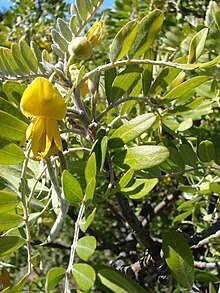| Sophora | |
|---|---|

| |
| Sophora chrysophylla flowers and leaves | |
| Scientific classification | |
| Kingdom: | Plantae |
| Clade: | Tracheophytes |
| Clade: | Angiosperms |
| Clade: | Eudicots |
| Clade: | Rosids |
| Order: | Fabales |
| Family: | Fabaceae |
| Subfamily: | Faboideae |
| Tribe: | Sophoreae |
| Genus: | Sophora L. (1753) |
| Type species | |
| Sophora tomentosa L.[1]
| |
| Species | |
|
59–116; see text | |
| Synonyms[2][3] | |
| |
Sophora is a genus of about 45 species of small trees and shrubs in the pea family Fabaceae. The species have a pantropical distribution.[4][5] The generic name is derived from sophera, an Arabic name for a pea-flowered tree.[6]
The genus formerly had a broader interpretation including many other species now treated in other genera, notably Styphnolobium (pagoda tree genus), which differs in lacking nitrogen fixing bacteria (rhizobia) on the roots, and Dermatophyllum (the mescalbeans). Styphnolobium has galactomannans as seed polysaccharide reserve, in contrast Sophora contains arabinogalactans, and Dermatophyllum amylose.
The New Zealand Sophora species are known as kowhai.[7]
The seeds of species such as Sophora affinis and Sophora chrysophylla are reported to be poisonous.[8]
- ^ "Sophora L." TROPICOS. Missouri Botanical Garden. Retrieved 2010-01-28.
- ^ Sophora L. Plants of the World Online. Retrieved 8 August 2023.
- ^ "Genus: Sophora L." Germplasm Resources Information Network. United States Department of Agriculture. 2006-11-03. Archived from the original on 2010-05-28. Retrieved 2009-11-23.
- ^ "PLANTS Profile Sophora nuttalliana B.L. Turner silky sophora". USDA Natural Resources Conservation Service. United States Department of Agriculture. Retrieved 2011-03-20.
- ^ "PLANTS Profile Sophora tomentosa L.yellow necklacepod". USDA Natural Resources Conservation Service. United States Department of Agriculture. Retrieved 2011-03-20.
- ^ Gledhill, D. (2008). The Names of Plants (4th ed.). Cambridge University Press. p. 356. ISBN 978-0-521-86645-3.
- ^ Heenan PB, de Lange PJ, Wilton AD (2001). "Sophora (Fabaceae) in New Zealand: taxonomy, distribution, and biogeography". New Zealand J Bot. 39 (1): 17–53. Bibcode:2001NZJB...39...17H. doi:10.1080/0028825X.2001.9512715.
- ^ Little, Elbert L. (1980). The Audubon Society Field Guide to North American Trees: Eastern Region. New York: Knopf. p. 529. ISBN 0-394-50760-6.